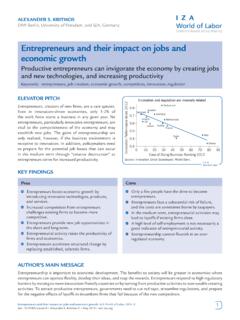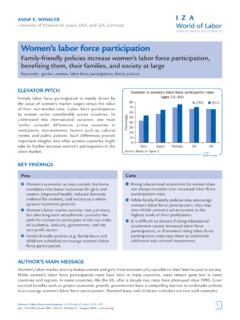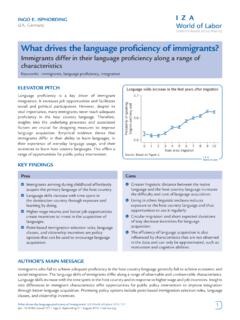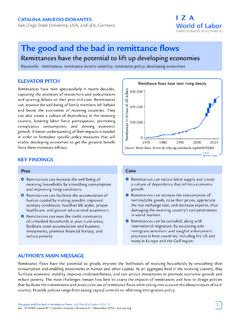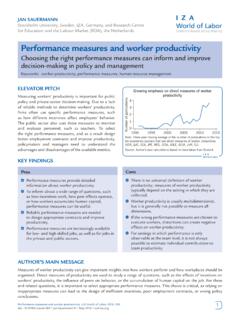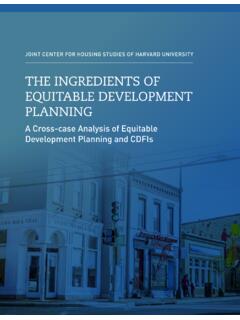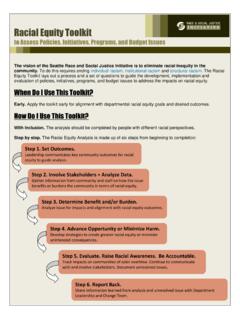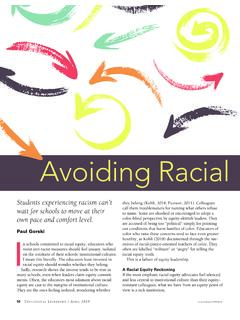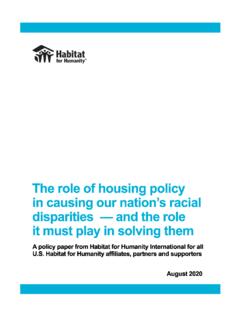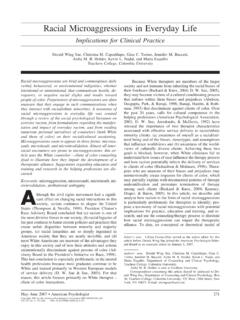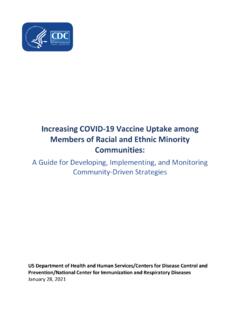Transcription of Slavery, racial inequality, and education - IZA World of Labor
1 Graziella BertocchiUniversity of Modena and Reggio Emilia, Italy, and IZA, GermanySlavery, racial inequality, and education . IZA World of Labor 2015: 122d o i: 5/ i z aw o | Graziella Bertocchi | February 2015 | Pros There is empirical evidence that shows a negative relationship between slavery and current educational outcomes. racial education inequality has been closing over time but is still persistent. racial education inequality can be traced to the legacy of colonial slavery . Colonial slavery affects current income inequality and its racial component via the channel of PitchIncome inequality is a critical issue in both political and public debate.
2 Educational attainment is a key causal factor of continuing inequality, since it influences human capital accumulation and, as a consequence, the unequal distribution of earnings. Educational inequality displays a racial dimension that is particularly persistent and difficult to eradicate through policy measures. Its roots lie in the colonial institution of slave Labor , which was widespread in the US and Latin America up until the 19th century. However, the influence of slavery differs significantly across countries and between S MaiN MeSS aGeEvidence suggests that in some countries historical slavery has influenced the racial distribution of human capital and income inequality.
3 A regional comparison of the influence of slavery on education , racial education inequality, and income distribution shows that policies aimed at addressing inequality can account for differential effects of past slavery on current outcomes. Policies designed to remove racial education inequalities in schools can favor income equalization, though given the resilience of the effect of past slavery they are by no means an immediate solution. Nevertheless, education policy clearly has a strong influence over Evidence on the relationship between slavery and current educational outcomes is rich for the US but less so for other regions. Latin America is characterized by persistent income and educational inequalities, but country experiences differ with respect to historical slavery .
4 slavery can be associated with a lower level of education ; but evidence on its differential effect across races is scarce. The influence of additional institutional factors ( development of mass education and a more assimilationist approach to the integration of former slaves) can limit the effect of slavery on , racial inequality, and educationHistorical slavery may be a driver of human capital and its unequal racial distribution, with implications for education and income inequalitiesKeywords: slavery , education , racial inequalityKeY FiNDiNGSS ource: Historical, Demographic, Economic, and Social Data: TheUnited States, 1790 2000. Online at: ; andUnited States Decennial Census 2000.
5 Online at: See [1] for education inequalityFitted education inequality increases with past slavery , US, 2000 IZA World of Labor | February 2015 | Bertocchi | slavery , racial inequality, and education MotiVatioNThe possible links between the institution of slave Labor and contemporary educational outcomes and income inequality is a focus of much political and public debate, with racial considerations being central to the discussions. In order to gain a better understanding of these issues, it is important to consider the available evidence on the impact of racial differences in education to overall differences in those countries that have historically experienced slavery , inequality in terms of education and income currently demonstrates a strong racial component.
6 This calls into question the possible effects of slavery on racial inequality. In particular, whether slavery has influenced the accumulation of human capital and its unequal distribution across racial groups. While slavery has been widespread all over the World for thousands of years, an analysis of the historical experience of slavery in the Americas following the trans-Atlantic slave trade is particularly informative. Documenting the evolution of racial education inequality in the US, its link with past slavery , and its implications for income inequality reveals a clear relationship between past slavery and contemporary education inequality across races, both in terms of the quality and the degree of trans-atlantic slave tradeOut of several slave-trade waves from Africa, the quantitatively most important one involved the shipping of slaves over the Atlantic and to the Americas.
7 The trans-Atlantic slave trade occurred between the 16th and 19th century and caused the forced migration of over 12 million data see: Eltis, D., S. D. Behrendt, D. Richardson, and H. S. Klein. The Trans-Atlantic Slave Trade: A Database on CD-Rom. Cambridge, UK: Cambridge University Press, an analysis of its consequences from the perspective, respectively, of sending and receiving countries, see: Nunn, N. The long-term effects of Africa s slave trades. Quarterly Journal of Economics 123:1 (2008): 139 176; and Soares, R. R., J. J. Assun o, and T. F. Goulart. A note on slavery and the roots of inequality. Journal of Comparative Economics 40:4 (2012): 565 , evidence from Latin America and the Caribbean highlights that there are regional differences in the relationship between slavery , education , and income inequality.
8 These differences are potentially due to institutional factors. For example, African slavery in this region was accompanied by local forms of Labor coercion. In addition, mass education developed more slowly. Finally, in Latin America and the Caribbean the white colonists opted for a culture of assimilation that led over time to widespread racial mixing. In contrast the US developed, up to a point, a segregated society in which black people still maintain a strong racial identity even to the present regional comparison reveals that policies aimed at addressing inequality can account for the differential effects of past slavery on current outcomes, with the educational channel clearly emerging as a very strong World of Labor | February 2015 | Bertocchi | slavery , racial inequality, and education DiScUSSioN oF ProS aND coNSthe USEvidence on human capital accumulation by raceThe economic literature on racial inequality in education in the US is extensive [2], [3].
9 The evidence documents the evolution of racial differences, both in the quality and the quantity of education . Following the American Civil War, African Americans had essentially no exposure to formal schooling. This was a legacy of the extremely high rates of illiteracy that prevailed in the southern plantations, where the vast majority of African Americans were employed. The next generations of the descendants from African slaves, initially still located mostly in the south, were able to complete far fewer years of schooling than white people. They also had access to racially segregated public schools, which provided a qualitatively inferior education in comparison to what was available to white people [4].
10 By 1940, as a result of the combination of low educational attainment and inferior educational quality, the racial gap was still very wide. Subsequently, however, as successive generations of black children received more and better schooling, the racial gap narrowed, with an eventual impact on earnings of racial education inequalityOverall, the evidence on the evolution of racial educational differences points to long-term convergence, but also to the persistence of disparities along racial lines [4]. This takes into account a wide number of dimensions, such as literacy rates, years of educational attainment, spending per pupil and returns to 1 shows the evolution of the racial gap, at the high school and the bachelor level, from 1940 to 2000.
